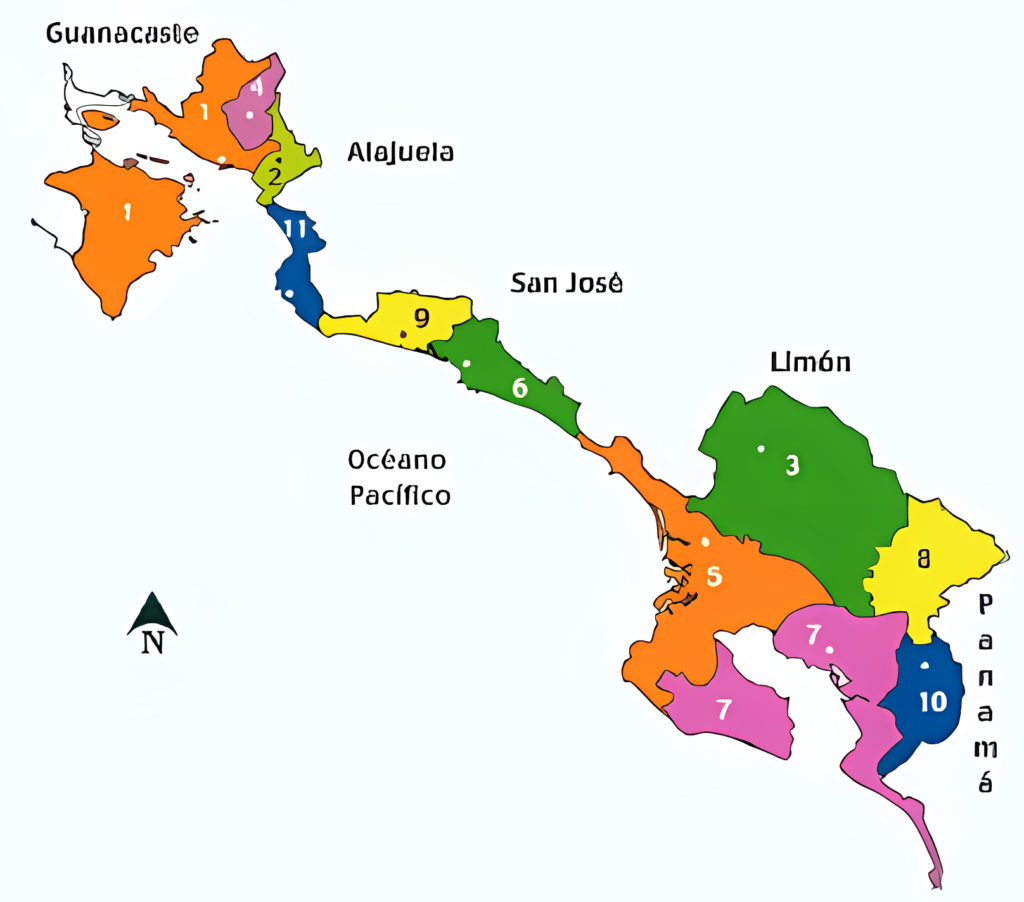
1. Puntarenas – 2. Esparza – 3. Buenos Aires – 4. Monte de Oro – 5. Osa – 6. Quepos – 7. Golfito – -8. Coto Brus – 9. Parrita – 10. Corredores – 11. Garabito
The province of Puntarenas, located in the western zone of Costa Rica, is a haven for tourists seeking natural beauty, rich culture, and an exciting history. Covering most of the Pacific coast of the country, the province is the largest in Costa Rica, spanning an area of 11,265 km². It is divided into 13 cantons and 60 districts, with a total population of 410,929 inhabitants, according to the 2011 census.
Puntarenas boasts a varied landscape, including high mountains, valleys, beaches, and coastal landscapes. The rugged coastline gives rise to numerous beaches and bays, making the province an attractive destination for tourism. The climate is dry tropical, with two well-defined seasons, and the province has numerous protected areas of great biological wealth, such as Cabo Blanco, Manuel Antonio, Monte Verde, and Corcovado.
But Puntarenas is not just about its natural beauty. The province has a rich history, dating back to pre-Columbian times. The region was inhabited by various Amerindian groups, including the huetares, the chorotegas, the quepoa, the bruncas, the nation of Coctú, and the buricas. These autochthonous groups had a subsistence agriculture based on maize, tubers, curcubits, and fishing. They had the presence of specialists who made various types of ceramics for both ritual and utilitarian purposes, as well as the manufacture of sumptuary objects of jade, gold, stone, and other materials, which were used as signs of rank. The stone spheres stood out mainly, a unique artistic and cultural manifestation of the Costa Rican aborigines of the southeastern area of the province of Puntarenas.
The Spanish crossed the Costa Rican Pacific coast for the first time in 1513, and in 1522, Gil González Dávila crossed the entire coast of Puntarenas. Francisco Hernández de Córdoba established the first Spanish settlement in Costa Rica near present-day Esparza in 1524. In 1529, Juan de Cavallón y Arboleda reached Chomes by way of Nicaragua and Nicoya, and he established the Real de la Ceniza, a Spanish garrison, between the mouths of the Machuca and Jesús María rivers, and from there he directed the explorations that, through the Grande de Tárcoles river, penetrated the Central Valley.
Today, Puntarenas is known for its cultural contributions to the country, highlighting the stone spheres, symbols of Costa Rica. The city of Puntarenas, known as “The Pearl of the Pacific,” was the country’s main port for much of its history, it became a National Resort in 1940, and today it continues to be a main point of reference on the coast of the Costa Rican Pacific. The presence of numerous cultural traditions throughout its history, both native peoples and immigrants, makes the culture of the province of Puntarenas one of the richest, most varied, and recognizable in Costa Rica.
For those seeking a combination of natural beauty, rich history, and culture, Puntarenas is a destination not to be missed. Whether you want to explore the rugged coastline, visit protected areas of great biological wealth, or immerse yourself in the rich cultural traditions of the province, Puntarenas has something for everyone.
